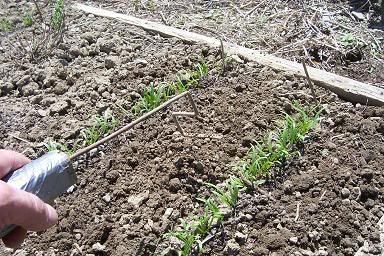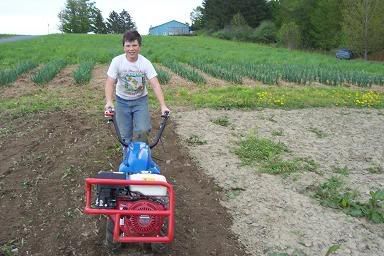The kiss of the sun for pardon,
The song of the birds for mirth,
One is nearer God’s heart in the garden
Than anywhere else on earth.
That portion of a poem by Dorothy Frances Gurney could well be the first bit of poetry I ever committed to memory, and I still like it. The statement may not be 100% theologically accurate, but it expresses an element of truth that I feel strongly about.
All of creation testifies to the greatness of God, and if we who call ourselves Christians live and work close to His creation, in accord with His creation, and dependent on His creation, we can not help but grow nearer to Him. That is my experience and my desire. All of which brings me to my garden.
Spring is Here and the Ash leaves are late, as usual
It is springtime here in central New York. The trees have now leafed out. The hillsides are once again green and it is a welcome sight. However, as always, the leaves of the ash trees are only now starting to emerge. Ash trees in the spring often look as if they have died over the winter, but they are just waiting their turn to leaf. Everything happens in its season, as God has ordained it.
When you work in your garden you notice the seasonal peculiarities of plants and trees and animals. Such little things are a wonder to discover. They never ceases to amaze and delight me.
Mangle Beet Update
Those of you who have followed this blog for long may remember the mangle beets I grew last year. Dave Taylor in Georgia sent me the seed and I chronicled the growth of the crop here. I harvested the massive beet roots in the fall, stored them in my basement, and fed them to my chickens over the winter.
But I saved some choice mangle specimens for spring. Yesterday I selected three of the now dry and shriveled roots and planted them in my garden. My hope is that the roots will put forth plants that will yield an abundance of mangle beet seeds. I’ve never done this sort of thing with a root crop before, but I desire seed independence and sustainability. Delicious mangle beet greens, roots for poultry feed, and seeds to replant—what a beautiful thing. I don’t know how well it will work for me. But the story continues, and I will keep you informed.
Introducing The Wire Weeder
I managed to plant some peas and spinach a couple weeks ago. This picture shows the spinach…

Yes, the plants are small but they are doing well. I am using a wire weeder tool in the picture to cultivate between the rows. The secret to keeping weeds out of the garden is to cultivate the ground often and to do so before you can clearly see the weeds. A wire weeder is nothing more than a piece of stiff wire that is run through the soil, just under the surface. It disrupts the freshly-sprouted weed seedlings-- those short, white, filaments of plant life looking to make their way in the world. Hundreds, even thousands, of determined weed seedlings can be destroyed with a simple swipe of the wire weeder. Gardening is a form of warfare.
I made my wire weeder myself. I utilized the stiff wire that is found in the support frame that holds those ubiquitous political signs that sprout up in front yards all over America every autumn. I cut a section of wire, clamped it in a vise, shaped it using a hammer, then inserted the end in a a block of wood (for a handle). I’ve made several such wire weeders. They don’t cost anything and they work just fine in my soil. But they do not work once the weeds have established themselves. Then it’s necessary to haul out the heavy artillery (a hoe).
Copra Onions
I like to grow an onion by the name of Copra. It grows very well in my soil and is an incredibly good keeper. Fact is, Marlene is still using Copra onions we harvested last fall. And they taste great too! Layer a few Copra slices between two thick slabs of Marlene’s homemade bread, add some mayonnaise, and sea salt, and you have an onion sandwich that can’t be beat.
I confess, Copra is a hybrid onion. I can not save seed from such an onion.So I have not reached total seed sustainability. But I’m working at it. Onions come sometime after mangle beets. I like to buy the Copra onions in sets. I’ve bought them from Johnny’s Seeds before. But when I went to Johnny’s site to get some, they were sold out. I did a search and found Dixondale Farms. To my relief, Dixondale had Copra sets in stock. I bought 10 bunches. That’s more than we need. But, like I said, they grow well for me and keep a long time. Perhaps we will be able to barter or sell them through the winter.
Tiller Boy
Here’s another picture from my spring garden…

That’s my son, James, doing some tilling. You can see my garlic patch in the background. The garlic is doing very well. If you look closely, in the upper right hand corner of the picture is my kid’s field car. It is still stuck in the neighbor’s field.
That tiller is made by BCS, an Italian company. Some people own fine Italian sports cars. I own a fine Italian rototiller. It’s the tiller that I purchased with profits from Herrick’s Homegrown Stiffneck Garlic Powder. That tiller actually cost me more money than the car I drive. But the car I drive only cost me $600.
============
The point of all this is that after a winter of waiting, I and my family are at last returning to the garden, and it is a very good thing. I’ll have more to say about this subject in the days ahead.
























































































































2 comments:
Herrick, have you tried the Candy onions? They are also VERY good keepers. I don't know if they are a hybrid or not though.
Are the Copra onions very mild and sweet?
Thanks for any insight here.
Hi Marci,
I think Copra onions are sweet but not real sweet. And they are mild but not real mild. Here's the description from Dixondale. It sums up the Copra onion very well:
"This is the best storage onion available. Its extra-hard medium-size bulbs will provide you onions for cooking until you have to plant again. The blocky round shape and thin necks allow the onions to dry quickly and they still have the highest sugar content of any storage type. Hybrid, stores approximately 10-12 months, matures in 110 days, globe-shaped, yellow."
Post a Comment